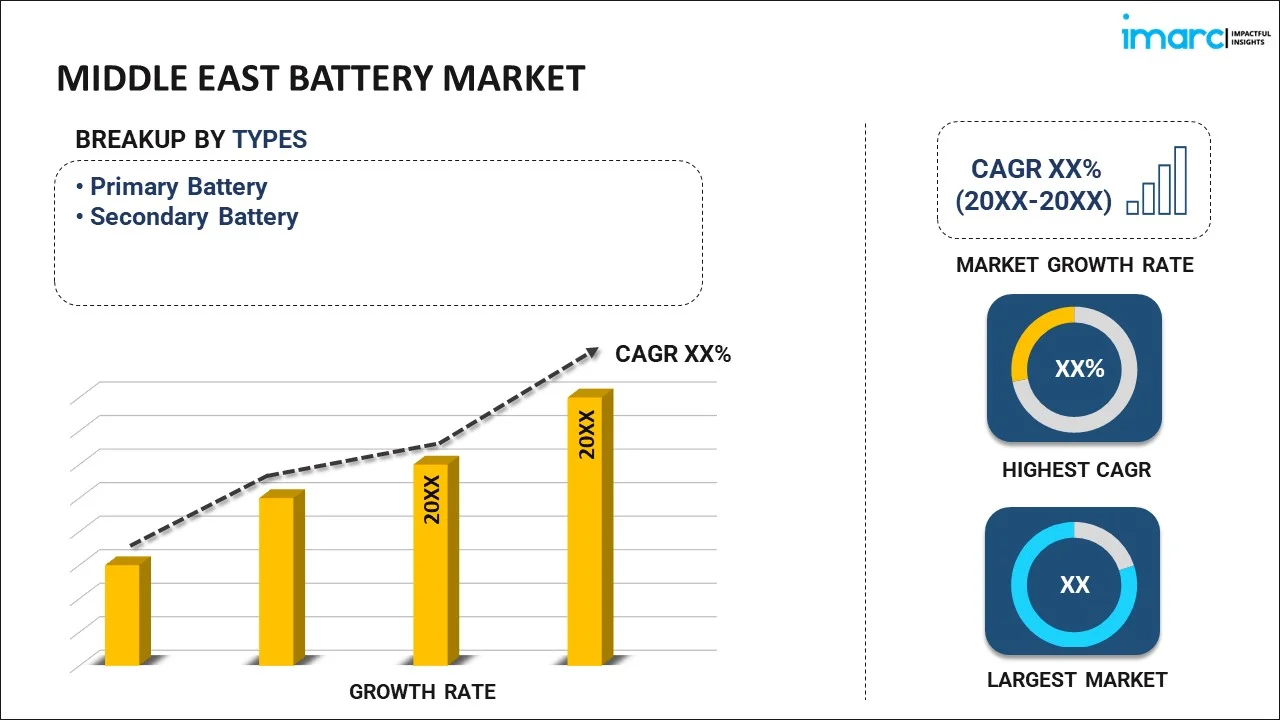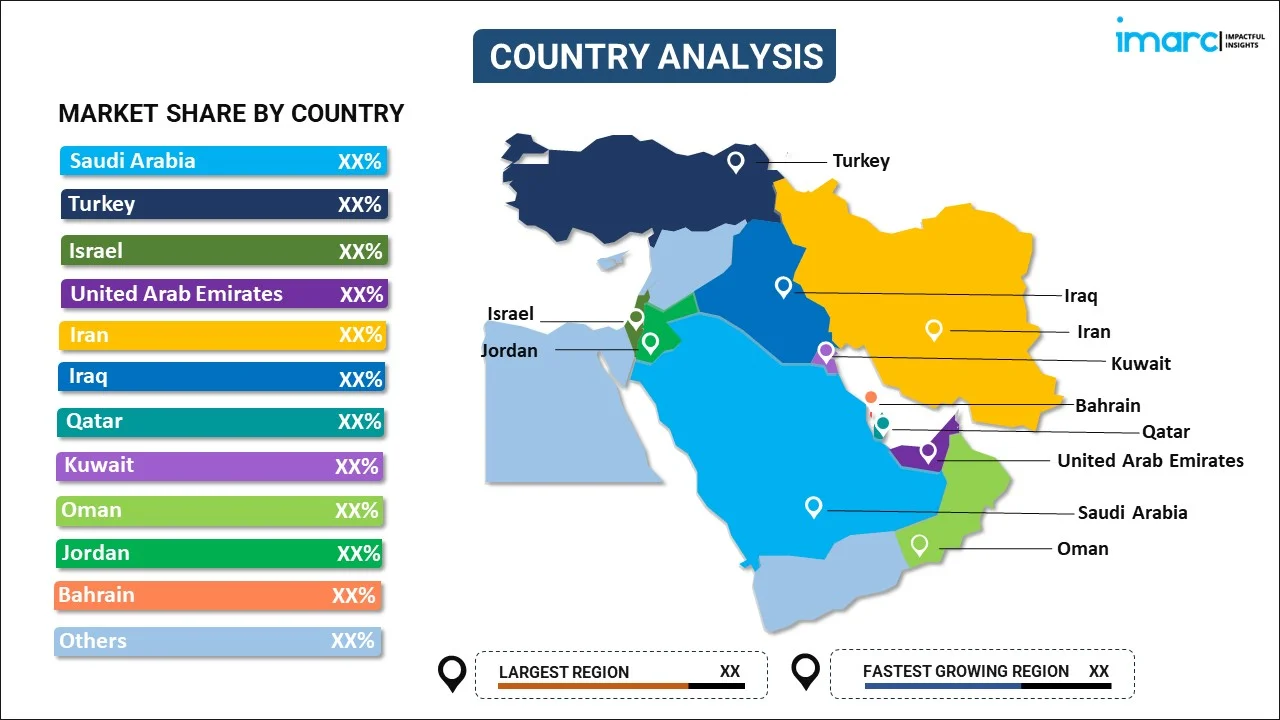
Middle East Battery Market Report by Type (Primary Battery, Secondary Battery), Product (Lithium-Ion, Lead Acid, Nickel Metal Hydride, Nickel Cadmium, and Others), Application (Automotive Batteries, Industrial Batteries, Portable Batteries), and Country 2024-2032
Market Overview:
Middle East battery market size is projected to exhibit a growth rate (CAGR) of 2.94% during 2024-2032. The growing shift towards sustainable energy sources to reduce the dependence on non-renewable energy sources, rising proliferation of connected devices, ranging from smart home appliances to industrial sensors, and increasing demand for utility-scale energy storage projects represent some of the key factors driving the market.
|
Report Attribute
|
Key Statistics
|
|---|---|
|
Base Year
|
2023 |
|
Forecast Years
|
2024-2032 |
|
Historical Years
|
2018-2023
|
| Market Growth Rate (2024-2032) | 2.94% |
A battery is a device that stores and releases electrical energy through electrochemical reactions. It consists of one or more electrochemical cells, each comprising positive and negative electrodes separated by an electrolyte. It is available as alkaline batteries, which are disposable, cost-effective, and have a long shelf life. It is also categorized as lithium-ion (Li-ion) batteries that are rechargeable batteries and offer high energy density and a longer cycle life. It includes lead-acid batteries, which are used in uninterruptible power supply (UPS) applications. It encompasses nickel-metal hydride (NiMH) batteries, which are rechargeable and often used in devices like digital cameras and power tools. It enables the portability of devices, making them convenient and user-friendly. It provides a flexible and portable source of power, allowing devices to be used in diverse environments without the need for a constant external power supply. It also plays a crucial role in the transition to a cleaner and more sustainable energy future by reducing reliance on fossil fuels.
Middle East Battery Market Trends:
At present, the increasing shift towards more sustainable and renewable energy sources to reduce the dependence on non-renewable energy sources and carbon footprint represents one of the crucial factors impelling the growth of the market in the Middle East. Besides this, governing agencies in the region are setting ambitious targets to reduce carbon emissions and facilitate the adoption of electric vehicles (EVs). This shift towards electric mobility is creating a rise in demand for Li-ion batteries with higher energy capacity, faster charging capabilities, and longer lifespan. In addition, as solar and wind power installations are proliferating, the need for effective energy storage solutions is becoming imperative. Batteries play a crucial role in storing excess energy generated during periods of high renewable energy production and releasing it during periods of high demand. The growing demand for utility-scale energy storage projects is also offering lucrative opportunities to battery manufacturers. Apart from this, increasing concerns associated with traditional battery disposal are compelling key market players to explore and develop alternative materials and designs that minimize ecological footprint. Manufacturers are also adopting circular economy principles, emphasizing the recycling and repurposing of battery materials to reduce waste and conserve resources. Additionally, the rising proliferation of connected devices, ranging from smart home appliances to industrial sensors, is catalyzing the demand for compact and long-lasting batteries. Moreover, the increasing popularity of solid-state batteries, as they offer higher energy density, improved safety, and longer lifespan, is bolstering the market growth in the region.
Middle East Battery Market Segmentation:
IMARC Group provides an analysis of the key trends in each segment of the market, along with forecasts at the regional and country levels for 2024-2032. Our report has categorized the market based on type, product, and application.
Type Insights:

- Primary Battery
- Secondary Battery
The report has provided a detailed breakup and analysis of the market based on the type. This includes primary battery and secondary battery.
Product Insights:
- Lithium-Ion
- Lead Acid
- Nickel Metal Hydride
- Nickel Cadmium
- Others
A detailed breakup and analysis of the market based on the product have also been provided in the report. This includes lithium-ion, lead acid, nickel metal hydride, nickel cadmium, and others.
Application Insights:
- Automotive Batteries
- Industrial Batteries
- Portable Batteries
The report has provided a detailed breakup and analysis of the market based on the application. This includes automotive batteries, industrial batteries, and portable batteries.
Country Insights:

- Saudi Arabia
- Turkey
- Israel
- United Arab Emirates
- Iran
- Iraq
- Qatar
- Kuwait
- Oman
- Jordan
- Bahrain
- Others
The report has also provided a comprehensive analysis of all the major regional markets, which include Saudi Arabia, Turkey, Israel, United Arab Emirates, Iran, Iraq, Qatar, Kuwait, Oman, Jordan, Bahrain, and Others.
Competitive Landscape:
The market research report has also provided a comprehensive analysis of the competitive landscape in the market. Competitive analysis such as market structure, key player positioning, top winning strategies, competitive dashboard, and company evaluation quadrant has been covered in the report. Also, detailed profiles of all major companies have been provided.
Middle East Battery Market Report Coverage:
| Report Features | Details |
|---|---|
| Base Year of the Analysis | 2023 |
| Historical Period | 2018-2023 |
| Forecast Period | 2024-2032 |
| Units | US$ Million |
| Scope of the Report | Exploration of Historical Trends and Market Outlook, Industry Catalysts and Challenges, Segment-Wise Historical and Future Market Assessment:
|
| Types Covered | Primary Battery, Secondary Battery |
| Products Covered | Lithium-Ion, Lead Acid, Nickel Metal Hydride, Nickel Cadmium, Others |
| Applications Covered | Automotive Batteries, Industrial Batteries, Portable Batteries |
| Countries Covered | Saudi Arabia, Turkey, Israel, United Arab Emirates, Iran, Iraq, Qatar, Kuwait, Oman, Jordan, Bahrain, Others |
| Customization Scope | 10% Free Customization |
| Report Price and Purchase Option | Single User License: US$ 3699 Five User License: US$ 4699 Corporate License: US$ 5699 |
| Post-Sale Analyst Support | 10-12 Weeks |
| Delivery Format | PDF and Excel through Email (We can also provide the editable version of the report in PPT/Word format on special request) |
Key Questions Answered in This Report:
- How has the Middle East battery market performed so far and how will it perform in the coming years?
- What has been the impact of COVID-19 on the Middle East battery market?
- What is the breakup of the Middle East battery market on the basis of type?
- What is the breakup of the Middle East battery market on the basis of product?
- What is the breakup of the Middle East battery market on the basis of application?
- What are the various stages in the value chain of the Middle East battery market?
- What are the key driving factors and challenges in the Middle East battery?
- What is the structure of the Middle East battery market and who are the key players?
- What is the degree of competition in the Middle East battery market?
Key Benefits for Stakeholders:
- IMARC’s industry report offers a comprehensive quantitative analysis of various market segments, historical and current market trends, market forecasts, and dynamics of the Middle East battery market from 2018-2032.
- The research report provides the latest information on the market drivers, challenges, and opportunities in the Middle East battery market.
- Porter's five forces analysis assist stakeholders in assessing the impact of new entrants, competitive rivalry, supplier power, buyer power, and the threat of substitution. It helps stakeholders to analyze the level of competition within the Middle East battery industry and its attractiveness.
- Competitive landscape allows stakeholders to understand their competitive environment and provides an insight into the current positions of key players in the market.
Need more help?
- Speak to our experienced analysts for insights on the current market scenarios.
- Include additional segments and countries to customize the report as per your requirement.
- Gain an unparalleled competitive advantage in your domain by understanding how to utilize the report and positively impacting your operations and revenue.
- For further assistance, please connect with our analysts.
 Inquire Before Buying
Inquire Before Buying
 Speak to an Analyst
Speak to an Analyst
 Request Brochure
Request Brochure
 Request Customization
Request Customization




.webp)




.webp)












